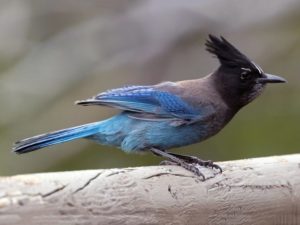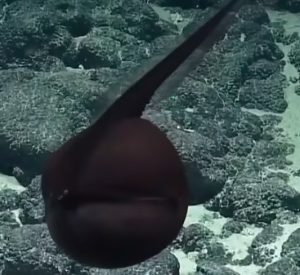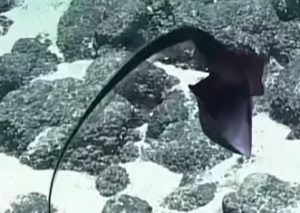Podcast: Play in new window | Download (Duration: 10:16 — 11.3MB)
Thanks to Brody, Oz, and Sam for their suggestions this week!
Further reading:
Two spectacled hare-wallabies hanging out under a spinifex bush [picture from this site]:

A regular swamp wallaby [photo by jjron – Own work, CC BY-SA 3.0, https://commons.wikimedia.org/w/index.php?curid=4022233]:

The glorious golden swamp wallaby [photo by Jack Evershed, taken from the first article linked above]:

The takin can also be golden:
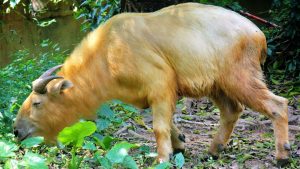
The gaur is so incredibly big! It’s so big, honestly, it’s just ridiculous:
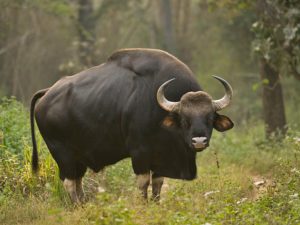
Show transcript:
Welcome to Strange Animals Podcast. I’m your host, Kate Shaw.
This week we have suggestions from Oz, Sam, and Brody, with some interesting mammals!
Let’s start with Brody’s suggestion, the wallaby! It’s been a while since we talked about the wallaby, which is an adorable marsupial closely related to the kangaroo. It’s native to Australia and New Guinea, part of the family Macropodidae.
One thing everyone knows about kangaroos, which is also true for wallabies, is that they hop instead of running. Their hind legs are extremely strong with big feet, and in fact the word Macropodidae means big feet. The animal hops by leaning forward and jumping, with its big hind feet leaving the ground at about the same time, and landing at the same time too before it bounces again. Its big tail helps it balance.
We talked about the wallaby last in episode 390, so let’s learn about some species of wallaby that we didn’t talk about then. For example, the spectacled hare-wallaby. It’s a small species that’s common in northern Australia and parts of Papua New Guinea. It’s active at night and is mostly solitary, so unless you’re wandering around at night you might not have seen one. It’s called the spectacled hare-wallaby because it has orange-colored fur around its eyes so that it looks sort of like it’s wearing glasses. The rest of its fur is brown, gray, and golden. Its ears are small and its tail and hind legs are very long, with short little front legs. It’s very cute.
The spectacled hare-wallaby prefers sandy or stony areas, like dunes and shrubland, where it can find lots of plants to eat but can easily hop away if it spots a predator. It’s smaller than a domestic cat, but it can travel incredibly fast when it wants to.
If you live along the eastern part of Australia, you might have seen the swamp wallaby, also called the black wallaby because it’s mostly dark gray or gray-brown in color, often with a white tip to the tail. It’s stocky and much larger than the spectacled hare-wallaby, almost three feet tall, or 85 cm, when it’s sitting up. It doesn’t just live in swamps but also likes forests and other areas with lots of places to hide. Unlike the spectacled hare-wallaby, it’s not that fast and can’t always outrun potential predators, but it’s good at hiding because its fur is so dark.
Most wallabies are grazers, meaning they mainly eat grass, but the swamp wallaby is a browser. Instead of having grinding teeth to break down grass, its teeth are sharper for cutting through plant material like bushes, shrubs, and ferns. The swamp wallaby will even use its front legs to pull branches into reach so it can eat the leaves.
Wallabies are marsupials, meaning the babies are born extremely early by our standards, crawl into the mother’s pouch and clamp onto a teat, and continue to develop in the pouch. Wallabies usually only have one baby at a time, but the mother swamp wallaby has two babies in its pouch almost all its adult life. The swamp wallaby has two uteruses, and a few days before the first baby is ready to be born, the female comes into estrus again, meaning she’s ready to mate. By the time her first baby is born, she’s already pregnant with her second baby. When the second baby is born, the first baby is old enough that’s it doesn’t spend all the time in the pouch—but by then, she’s already pregnant with her third baby. By the time the third baby is born, the first baby is grown up and on its own, the second baby is old enough that it isn’t in the pouch all the time, and—you guessed it—the mother is already pregnant with baby four. It sounds exhausting, but it works well for the swamp wallaby.
As I mentioned, the swamp wallaby is also called the black wallaby, but there’s a rare color variation that’s called a golden swamp wallaby. It’s still a swamp wallaby but its fur is golden yellow and it has a white face. The coloration is due to a mutation in coat color, but golden swamp wallabies seem to be perfectly safe in the few areas where they’re found, so it doesn’t seem to be a detriment. Some scientists suspect the color morph is helpful in open forests with sandier soil, which is exactly where the golden swamp wallabies are found.
Speaking of golden animals, let’s talk next about the takin, suggested by Sam. We talked about the golden takin back in episode 218, which is a subspecies of takin. The takin is closely related to sheep and mountain goats, but it looks more like a small musk ox.
The takin lives in the eastern Himalaya Mountains, and is a strong, stocky animal with a lot of adaptations to intense cold. It has a thick coat that grows even thicker in winter, with a soft, dense undercoat to trap heat next to the body. It also has large sinus cavities that warm the air it breathes before it reaches the lungs, which means it has a big snoot. Its skin is oily, which acts as a water repellent during rain and snowstorms. In spring it migrates to high elevations, but when winter starts it migrates back down to lower elevations where it’s not quite as cold.
It will eat just about any plant material it can reach, including tree bark, tough evergreen leaves, and bamboo. It sometimes shares the same bamboo forests where pandas live. It will even sometimes push over small trees so it can eat the leaves. It visits salt licks regularly, and some researchers think it needs the minerals available at salt licks to help neutralize the toxins found in many plants it eats.
Both male and female takins have horns, which grow sideways and back from the forehead in a crescent and can be almost three feet long, or 90 cm. It can stand over four feet tall at its humped shoulder, or around 1.4 m. Its fur is mainly golden-brown with gray and white patches.
A full-grown takin is big enough and strong enough that it doesn’t have many predators. If a bear or wolf threatens it, it can run fast if it needs to or hide in dense underbrush. But it’s just a little tiny baby compared to our last animal this week, suggested by Oz: the gaur. [pronounced gow-ur]
We’ve only mentioned the gaur once on the podcast, way back in episode 58, when I mispronounced it “gar.” It’s the largest living bovid, also called the Indian bison, although it doesn’t just live in India. It’s native to southeast Asia, but it’s increasingly rare due to habitat loss and poaching, even though it’s a protected animal.
The gaur looks kind of like a domestic cow, but much larger. It’s dark brown and its lower legs are white, as is its nose. It has a fairly short tail and long curving horns that are mostly pale but black at the tips, and its ears are large. Females are lighter in color than males and calves are a pale sandy-brown.
How big is the gaur? A big bull can grow over seven feet high at the shoulder, or 2.2 meters, and it’s even a bit taller if you measure it at the muscular hump just behind the shoulder. It’s an incredibly heavy animal too, with only elephants, rhinos, hippos, and giraffes being heavier than a big bull. A bull can weigh over 3,300 lbs, or 1,500 kg. It’s so massive and muscular that bulls in particular look like they just got back from the gym and they’re flexing to show off.
The gaur is a bovid, but it doesn’t eat very much grass. Like the swamp wallaby, it’s a browser. It’s mainly found in forests, where it eats leaves, flowers, fruit, and even the bark of some trees, and it lives in herds of about a dozen animals each led by a wise old cow.
Almost the only predator that can kill a full-grown gaur is a tiger, and naturally the gaur does not like tigers at all as a result. If a herd spots a tiger, they form a ring around the calves to protect them, and if the tiger tries to approach, the adult gaurs attack and try to drive the tiger away. Sometimes the gaurs can even kill the tiger. At night the adult gaurs make a ring around the calves this same way, so that if a tiger or other predator approaches in the night, the adults are ready to defend their babies as soon as they wake up. Personally, if I were a tiger I think I wouldn’t bother trying to kill a gaur.
You can find Strange Animals Podcast at strangeanimalspodcast.blubrry.net. That’s blueberry without any E’s. If you have questions, comments, or suggestions for future episodes, email us at strangeanimalspodcast@gmail.com. We also have a Patreon at patreon.com/strangeanimalspodcast if you’d like to support us for as little as one dollar a month and get monthly bonus episodes.
Thanks for listening!
